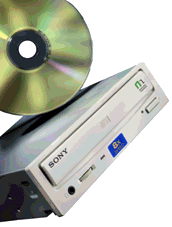The second factor that
determines your drive's performance is the seek time, sometimes called the
access time. The seek time is the average length of time it takes the
drive to find a certain piece of data. As the transfer rates increased,
the seek times decreased. Most Quad-speed drives' seek times were around
240 ms, whereas 8x drives are as low as 140 ms. This is where you get
ripped off if you get too much of a "bargain." The first 6x and 8x drives
had access times so high they weren't effectively faster than a
triple-speed or quad-speed. You could be buying one of these. Not
necessarily an older drive, but an older model. The technology has
developed to a point now where access times are as low as 140 ms, and are
constantly improving. Make sure that your access time is close to or
under 200 ms, and under 175 if you want good performance. "If it seems
too good to be true, it probably is." This old axiom holds a lot of truth
in it. If you can't believe the deal you're getting, then ask a friend or
co-worker who knows about computers to take a look at it. I thought that
the price of the drive I recently purchased was too low, but I researched
it thoroughly and couldn't find anything wrong. It works flawlessly and
performs excellently.
So there are good deals out there, you just have to look. Here are a
few other things you want to look for:
- The interface type. If
you have an EIDE controller, don't buy a SCSI drive.
- If you plan on
mounting the drive sideways, make sure it has clips on the tray to hold
the CD in.
- You may want a drive with manual track advance and play
buttons if you plan to listen to a lot of audio CDs.
The editors
suggest (but do not endorse) the following manufacturers. These are the
drives we have has good experiences with. It doesn't mean all of their
products are perfect, or that other makers' are not. They are just
suggestions.
NEC
Teac
Panasonic
And here's where you
can buy them online:
CDW
Insight
Elek-Tek
Seth Waddell
[back to verbosity] 